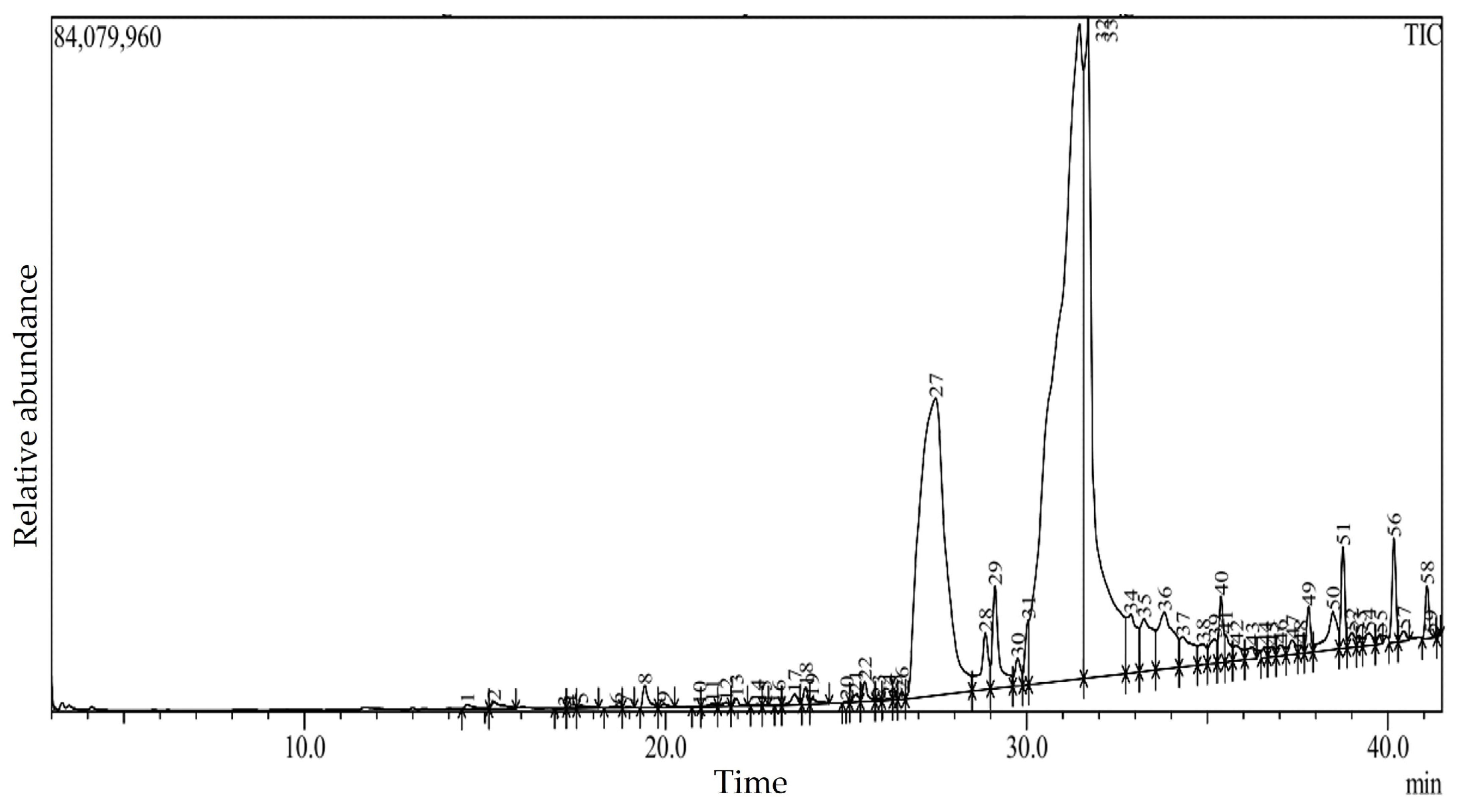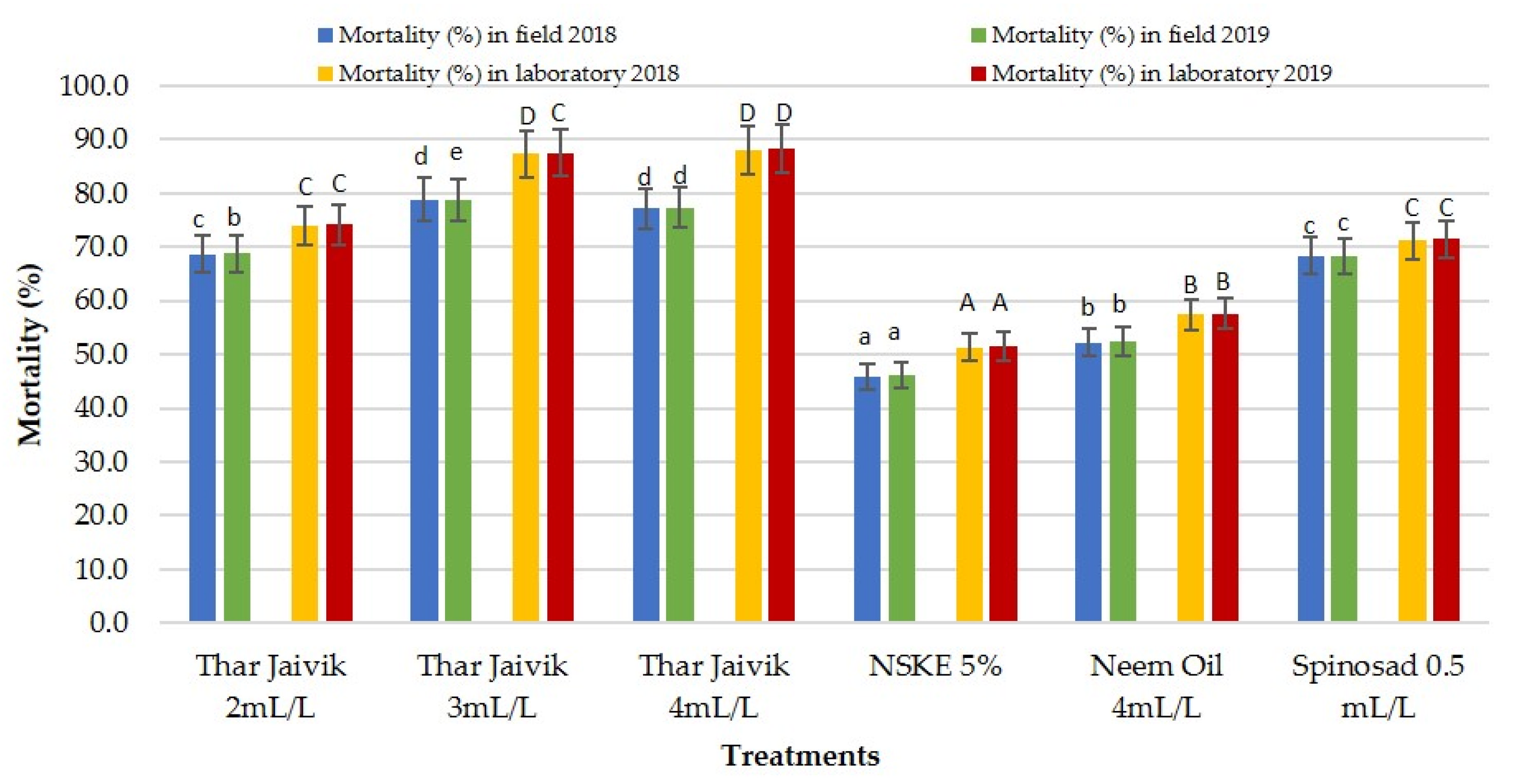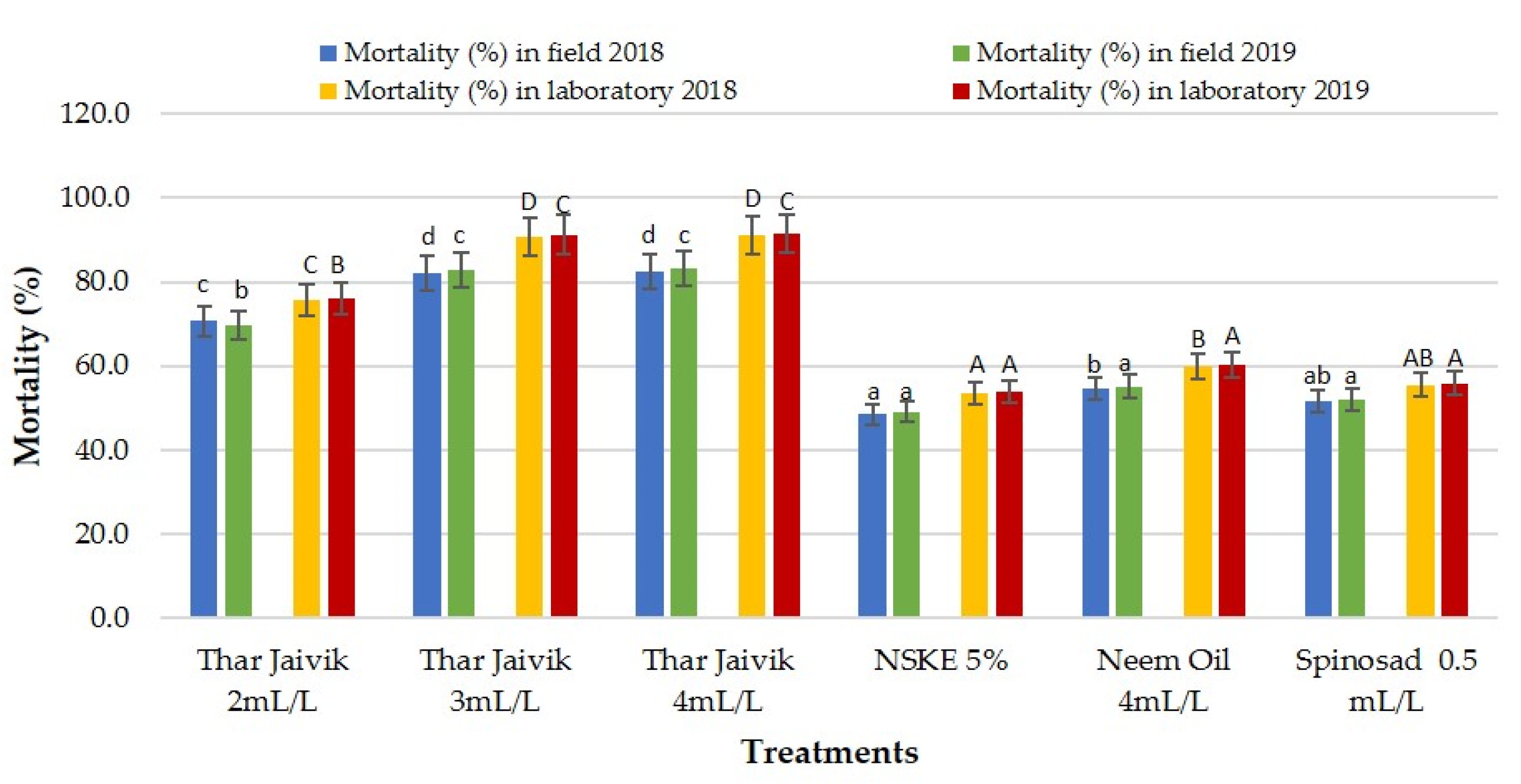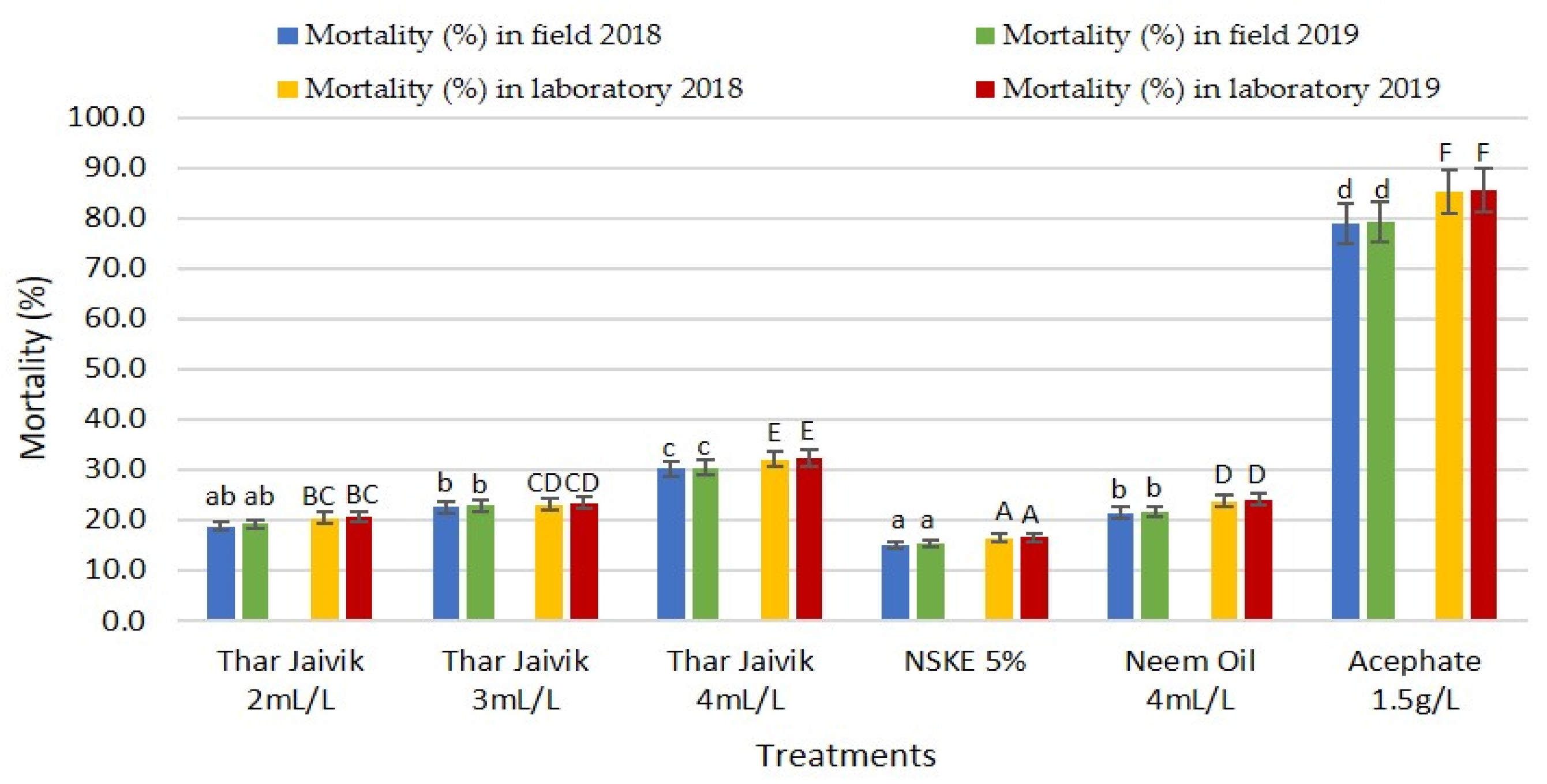Bitter Melon Novel Bioformulation “Thar Jaivik 41 EC”: Characterization and Bio-Efficacy Assessment as a Biopesticide on Horticulture Crops
Abstract
1. Introduction
2. Materials and Methods
2.1. Plant Material and Experimental Site
2.2. Petroleum Ether Extraction of Bitter Apple Seed
2.3. Gas Chromatography and MS/MS Analyses
2.4. Formulation of Biopesticide “Thar Jaivik 41 EC”
2.5. Rearing of Insects
2.6. Bioassays Used as Treatments
2.7. Phytotoxicity Effect of “Thar Jaivik 41 EC”
2.8. Statistical Analysis
3. Results and Discussion
3.1. Gas Chromatography and MS/MS Analyses
3.2. Bioassay against H. armigera
3.3. Bioassay against T. citricida
3.4. Bioassay against Bioagent C. septempunctata
3.5. Phytotoxicity Effect of “Thar Jaivik 41 EC”
4. Conclusions
Author Contributions
Funding
Institutional Review Board Statement
Data Availability Statement
Acknowledgments
Conflicts of Interest
References
- Haldhar, S.M.; Bhargava, R.; Berwal, M.K.; Saroj, P.L. Noval biopesticide compositions and formulation from bitter apple (Citrullus colocynthis) for insect control. Pat. Off. J. 2019, 20, 20435. [Google Scholar]
- Fetoh, B.E.-S.A.; Asiry, K.A. Toxicological and larvicidal activities of Alzanzalakhet, Melia azedarach against cucurbit fly, Dacus ciliatus at Hail Province in Saudi Arabia. Toxicol. Environ. Chem. 2012, 94, 1350–1356. [Google Scholar] [CrossRef]
- Ahmed, M.; Peiwen, Q.; Gu, Z.; Liu, Y.; Sikandar, A.; Hussain, D.; Javeed, A.; Shafi, J.; Iqbal, M.F.; An, R. Insecticidal activity and biochemical composition of Citrullus colocynthis, Cannabis indica and Artemisia argyi extracts against cabbage aphid (Brevicoryne brassicae L.). Sci. Rep. 2020, 10, 522. [Google Scholar] [CrossRef]
- Isman, M.B. Botanical insecticides, deterrents, and repellents in modern agriculture and an increasingly regulated world. Annu. Rev. Entomol. 2006, 51, 45–66. [Google Scholar] [CrossRef] [PubMed]
- Koul, O.; Walia, S.; Dhaliwal, G. Essential oils as green pesticides: Potential and constraints. Biopestic. Int. 2008, 4, 63–84. [Google Scholar]
- Naumann, K.; Isman, M.B. Toxicity of a neem (Azadirachta indica A. Juss) insecticide to larval honey bees. Am. Bee J. 1996, 136, 518–520. [Google Scholar]
- Lal, C.; Verma, L. Use of certain bio-products for insect-pest control. Indian J. Tradit. Knowl. 2006, 5, 79–82. [Google Scholar]
- Chandrashekharaiah, M.; Satish, S.; Vasudev, K.; Arya, V.V.; Narasimhamurthy, G. Efficacy of plant and aboriginal preparations against diamondback moth, Plutella xylostella (L.) (Lepidoptera: Plutellidae). J. Entomol. Zool. Stud. 2015, 3, 18–23. [Google Scholar]
- Bozsik, A. Studies on aphicidal efficiency of different stinging nettle extracts. Anz. Schädlingskunde Pflanzenschutz Umweltschutz 1996, 69, 21–22. [Google Scholar] [CrossRef]
- Macêdo, M.E.; Consoli, R.A.; Grandi, T.S.; dos Anjos, A.M.; de Oliveira, A.B.; Mendes, N.M.; Queiróz, R.O.; Zani, C.L. Screening of Asteraceae (Compositae) plant extracts for larvicidal activity against Aedes fluviatilis (Diptera: Culicidae). Mem. Inst. Oswaldo Cruz 1997, 92, 565–570. [Google Scholar] [CrossRef]
- Perry, A.S.; Yamamoto, I.; Ishaaya, I.; Perry, R.Y. Insecticides in Agriculture and Environment: Retrospects and Prospects; Springer Science & Business Media: Berlin/Heidelberg, Germany, 2013. [Google Scholar]
- Ranga Rao, G.; Rupela, O.; Wani, S.; Rahman, S.; Jyothsna, J.; Rameshwar Rao, V.; Humayun, P. Bio-intensive pest management reduces pesticide use in India. Pestic. News 2007, 76, 16–17. [Google Scholar]
- Bikdeloo, M.; Colla, G.; Rouphael, Y.; Hassandokht, M.R.; Soltani, F.; Salehi, R.; Kumar, P.; Cardarelli, M. Morphological and physio-biochemical responses of watermelon grafted onto rootstocks of wild watermelon [Citrullus colocynthis (L.) Schrad] and commercial interspecific cucurbita hybrid to drought stress. Horticulturae 2021, 7, 359. [Google Scholar] [CrossRef]
- Berwal, M.K.; Ram, C.; Gurjar, P.S.; Gora, J.S.; Kumar, R.; Verma, A.K.; Singh, D.; Basile, B.; Rouphael, Y.; Kumar, P. The Bioactive Compounds and Fatty Acid Profile of Bitter Apple Seed Oil Obtained in Hot, Arid Environments. Horticulturae 2022, 8, 259. [Google Scholar] [CrossRef]
- Javadzadeh, H.R.; Davoudi, A.; Davoudi, F.; Valizadegan, G.; Goodarzi, H.; Mahmoodi, S.; Ghane, M.R.; Faraji, M. Citrullus colocynthis as the Cause of Acute Rectorrhagia. Case Rep Emerg. Med. 2013, 2013, 652192. [Google Scholar]
- Tarraf, W.; Laquale, S.; De Mastro, G.; D’Addabbo, T. The potential of Citrullus colocynthis oil as a biocide against phytoparasitic nematodes. Crop Protect. 2019, 124, 104843. [Google Scholar] [CrossRef]
- Meena, N.; Singh, B.; Lal, G.; Kant, K.; Meena, R. Sustainable management of aphid in coriander (Coriandrum sativum L.) through botanicals and bio-pesticides. Int. J. Seed Spices 2016, 6, 25–31. [Google Scholar]
- Prabuseenivasan, S.; Jayakumar, M.; Raja, N.; Ignacimuthu, S. Effect of bitter apple, Citrullus colocynthis (L.) Schrad seed extracts against pulse beetle, Callosobruchus maculatus Fab. (Cole-optera: Bruchidae). Entomon-Trivandrum 2004, 29, 81–84. [Google Scholar]
- Korat, D.; Dengale, K. Cow urine-A natural animal by product for insect pest suppression. Green Farm. 2011, 2, 502–504. [Google Scholar]
- Miah, M.N.A.; Miah, M.R.U.; Hossain, M.M.; Haque, M.E. Insecticidal effects of cattle urine and indigenous plant extracts against sugarcane mealybugs. Am. J. Zool. 2018, 1, 35–39. [Google Scholar]
- Chauhan, R.S. Immunomodulatory properties of indigenous cow urine. MOJ Immunol. 2018, 6, 302–303. [Google Scholar] [CrossRef]
- Randhava, G.K.; Sharma, R. Chemotherapeutic potential of cow urine: A review. J. Intercult Ethnopharmacol. 2015, 4, 180–186. [Google Scholar] [CrossRef]
- Naseri, B.; Fathipour, Y.; Moharramipour, S.; Hosseininaveh, V. Comparative life history and fecundity of Helicoverpa armigera (Hubner) (Lepidoptera: Noctuidae) on different soybean varieties. Entomol. Sci. 2009, 12, 147–154. [Google Scholar] [CrossRef]
- Abbott, W.S. A method of computing the effectiveness of an insecticide. J. Econ. Entomol 1925, 18, 265–267. [Google Scholar] [CrossRef]
- Tallamy, D.W.; Stull, J.; Ehresman, N.P.; Gorski, P.M.; Mason, C.E. Cucurbitacins as feeding and oviposition deterrents to insects. Environ. Entomol. 1997, 26, 678–683. [Google Scholar] [CrossRef]
- Mansour, F.; Azaizeh, H.; Saad, B.; Tadmor, Y.; Abo-Moch, F.; Said, O. The potential of middle eastern flora as a source of new safe bio-acaricides to control Tetranychus cinnabarinus, the carmine spider mite. Phytoparasitica 2004, 32, 66–72. [Google Scholar] [CrossRef]
- Mollashahi, H.; Mirshekari, A.; Ghorbani, M.; Tarrah, A. Insecticidal effect of the fruit extract bitter melon (Citrullus colocynthis) on locust Chrotogonus trachypterus (Orth: Pyrgomorphidae). Biosci. Biotechnol. Res. Asia 2017, 14, 1285–1289. [Google Scholar] [CrossRef]
- Asiry, K.A. Aphidicidal activity of different aqueous extracts of bitter apple Citrullus colocynthis (L.) against the bird cherry-oat aphid, Rhopalosiphum padi (L.) (Homoptera: Aphididae) under laboratory conditions. S J Anim. Plant Sci. 2015, 25, 456–462. [Google Scholar]
- Jeon, J.-H.; Lee, H.-S. Biofunctional constituent isolated from Citrullus colocynthis fruits and structure–Activity relationships of its analogues show acaricidal and insecticidal efficacy. J. Agric. Food Chem. 2014, 62, 8663–8667. [Google Scholar] [CrossRef]
- Rahuman, A.A.; Gopalakrishnan, G.; Venkatesan, P.; Geetha, K. Larvicidal activity of some Euphorbiaceae plant extracts against Aedes aegypti and Culex quinquefasciatus (Diptera: Culicidae). Parasitol. Res. 2008, 102, 867–873. [Google Scholar] [CrossRef]
- Shekhara, C.; Rachappa, V.; Yelshetty, S.; Sreenivas, A. Biorationals for eco-friendly management of gram pod borer, Helicoverpa armigera (Hubner) on chickpea. J. Exp. Zool. India 2014, 17, 679–682. [Google Scholar]
- Ali, S.; Li, Y.; Haq, I.U.; Abbas, W.; Shabbir, M.Z.; Khan, M.M.; Mamay, M.; Niaz, Y.; Farooq, T.; Skalicky, M. The impact of different plant extracts on population suppression of Helicoverpa armigera (Hub.) and tomato (Lycopersicon esculentum Mill) yield under field conditions. PLoS ONE 2021, 16, e0260470. [Google Scholar] [CrossRef] [PubMed]
- Das, P.; Das, S.K.; Mishra, A.; Rattan, S.R.P.; Raddy, S.G.; Arya, H.P.S. Validation of Indigenous Technical Knowledge in Agriculture; Document; ICAR: New Delhi, India, 2004; Volume 4, pp. 78–85. [Google Scholar]
- Bharati, S. Role of Organics and Indigenous Components against Spodoptera litura (Fab.) in Groundnut and Soybean. M.Sc. (Ag.) Thesis, University of Agricultural Sciences, Dharwad, India, 2005; pp. 1–132. [Google Scholar]
- Barapatre, A.; Lingappa, S. Larvicidal and antifeedant activity of indigenous plant protection practices for Helicoverpa armigera (Hub). In In Proceedings of the Frontier Areas of Entomological Research; Indian Agricultural Research Institute: New Delhi, India, 2003; pp. 335–336. [Google Scholar]
- Silva, G.; Rodríguez, J.C.; Blanco, C.A.; Lagunes, A. Bioactivity of a water extract of boldus (Peumus boldus Molina) against Spodoptera frugiperda (JE Smith) and Helicoverpa zea Boddie (Lepidoptera: Noctuidae). Chilean J. Agric. Res. 2013, 73, 135–141. [Google Scholar] [CrossRef]
- Hassam, U.; Gulzar, A.; Rasool, B.; Zafar, S.; Younis, T.; Shakeel, M.; Khan, D.; Ullah, S.; Khaliq, S.; Ahmad, S. Efficacy of Citrullus colocynthis seed extract on Earias vittella, Fabricius, (Lepidoptera: Noctuidae): Environment sustainable approach. Braz. J. Biol. 2022, 84, e254479. [Google Scholar] [CrossRef] [PubMed]
- Gulzar, A.; Maqsood, A.; Munir, A.; Tariq, M.; Ali, M.; Qureshi, R. Toxicity, antifeedant and sub-lethal effects of Citrullus colocynthis extracts on cotton bollworm, Helicoverpa armigera (Lepidoptera: Noctuidae). Pak. J. Zool. 2017, 49, 2019–2026. [Google Scholar] [CrossRef]
- Amoabeng, B.W.; Gurr, G.M.; Gitau, C.W.; Nicol, H.I.; Munyakazi, L.; Stevenson, P.C. Tri-trophic insecticidal effects of African plants against cabbage pests. PLoS ONE 2013, 8, e78651. [Google Scholar] [CrossRef]
- Pissinati, A.; Ventura, M. Control of cabbage aphid, Brevicoryne brassicae (L.) using kaolin and neem oil. J. Entomol. 2015, 12, 48–54. [Google Scholar] [CrossRef]
- Iqbal, M.; Kahloon, M.; Nawaz, M.; Javaid, M. Effectiveness of some botanical extracts on wheat aphids. J. Anim. Plant Sci. 2011, 21, 114–115. [Google Scholar]
- Santos, T.M.d.; Costa, N.P.; Torres, A.L.; Boiça Júnior, A.L. Effect of neem extract on the cotton aphid. Pesqui. Agropec. Bras. 2004, 39, 1071–1076. [Google Scholar] [CrossRef]
- Simmonds, M.; Manlove, J.; Blaney, W.; Khambay, B. Effect of Botanical Insecticides on the Foraging and Feeding Behavior of the Coccinellid Predator Cryptolaemus montrouzieri. Phytoparasitica 2000, 28, 99–107. [Google Scholar] [CrossRef]
- Duraimurugan, P.; Regupathy, A. Influence of trap crops and application of neem seed kernel extract on the occurrence of natural enemies in cotton ecosystem. Resist. Pest Manag. Newsl. 2005, 15, 7–9. [Google Scholar]
- Hwang, I.-C.; Kim, J.; Kim, H.-M.; Kim, D.-I.; Kim, S.-G.; Kim, S.-S.; Jang, C. Evaluation of toxicity of plant extract made by neem and matrine against main pests and natural enemies. Korean J. Appl. Entom. 2009, 48, 87–94. [Google Scholar] [CrossRef]
- Tian, Y.; Chen, Z.; Huang, X.; Zhang, L.; Zhang, Z. Evaluation of Botanicals for Management of Piercing–Sucking Pests and the Effect on Beneficial Arthropod Populations in Tea Trees Camellia sinensis (L.) O. Kuntze (Theaceae). J. Insect Sci. 2020, 20, 27. [Google Scholar] [CrossRef] [PubMed]
- Ma, T.; Yan, H.; Shi, X.; Liu, B.; Ma, Z.; Zhang, X. Comprehensive evaluation of effective constituents in total alkaloids from Sophora alopecuroides L. and their joint action against aphids by laboratory toxicity and field efficacy. Ind. Crops Prod. 2018, 111, 149–157. [Google Scholar] [CrossRef]
- Hikal, W.-M.; Baeshen, R.-S.; Hussein, A.-H.S. Botanical insecticide as simple extractives for pest control. Cogent Biol 2017, 3, 1. [Google Scholar] [CrossRef]
- Lengai, G.M.W.; Muthomi, J.W.; Mbega, E.R. Phytochemical activity and role of botanical pesticides in pest management for sustainable agricultural crop production. Sci. Afr. 2020, 7, e00239. [Google Scholar] [CrossRef]
- Werrie, P.-Y.; Juillard, A.; Heintz, C.; Brisset, M.-N.; Fauconnier, M.-L. Phytotoxicity and Plant Defence Induction by Cinnamomum cassia Essential Oil Application on Malus domestica Tree: A Molecular Approach. Agronomy 2022, 12, 512. [Google Scholar] [CrossRef]
- Pavela, R. Effectiveness of some botanical insecticides against Spodoptera littoralis Boisduvala (Lepidoptera: Noctudiae), Myzus persicae Sulzer (Hemiptera: Aphididae) and Tetranychus urticae Koch (Acari: Tetranychidae). Plant Protect. Sci. 2009, 45, 161–167. [Google Scholar] [CrossRef]






| Name of the Phytochemicals | Retention Time | Area (%) | Height (%) | Role of the Phytochemicals |
|---|---|---|---|---|
| Octadecanoic acid | 31.46 | 42.65 | 23.30 | Antimicrobial activity, insecticide, miticide |
| n-hexadecanoic acid | 27.48 | 19.64 | 10.57 | Insecticide, nematicide, 5-alpha reductase inhibitor, antipsychotic |
| 9, 12-octadecadienoic acid (Z,Z)- | 31.70 | 17.35 | 23.49 | Antimicrobial activity, insecticide, miticide |
| 9,12-octadecadienoic acid (Z,Z)-, methyl ester | 29.12 | 1.69 | 3.63 | Insecticidal property |
| Dotriacontance | 32.88 | 1.53 | 2.07 | Insecticidal property |
| 6-octadecenoic acid, methyl ester | 28.86 | 1.09 | 2.00 | Antimicrobial activity, insecticide, miticide |
| Hexatriacontane | 40.17 | 0.99 | 3.70 | Insecticidal property |
| Biopesticides | Mortality in H. armigera Larvae (%) | |||
|---|---|---|---|---|
| Field Conditions | Laboratory Conditions | |||
| After One Day | After Three Days | After One Day | After Three Days | |
| Thar Jaivik 2 mL L−l | 65.68 (54.12) c | 71.95 (58.00) c | 70.62 (57.19) c | 77.58 (61.74) c |
| Thar Jaivik 3 mL L−l | 75.08 (60.10) d | 82.63 (65.37) e | 84.25 (66.62) d | 90.72 (72.48) d |
| Thar Jaivik 4 mL L−l | 75.77 (60.49) d | 78.80 (62.56) d | 85.40 (67.56) d | 91.08 (72.69) d |
| NSKE 5% | 43.72 (41.37) a | 48.27 (43.99) a | 50.47 (45.25) a | 52.43 (46.38) a |
| Neem Oil 4 mL L−l | 50.32 (45.16) b | 54.38 (47.50) b | 56.55 (48.75) b | 58.51 (49.88) b |
| Spinosad 0.5 mL L−l | 65.22 (53.87) c | 71.43(57.69) c | 68.18 (55.65) c | 74.42 (59.60) c |
| Sem | 0.96 | 0.72 | 0.90 | 1.16 |
| LSD (p = 0.05) | 2.99 | 2.24 | 2.75 | 3.56 |
| Biopesticides | Mortality (%) in Aphid Population | |||
|---|---|---|---|---|
| Field Conditions | Laboratory Conditions | |||
| After One Day | After Three Days | After One Day | After Three Days | |
| Thar Jaivik 2 mL L−l | 67.67 (55.35) c | 72.75 (58.53) b | 72.37 (58.29) c | 79.42 (63.02) b |
| Thar Jaivik 3 mL L−l | 78.53 (62.39) d | 86.42 (68.50) c | 87.45 (69.31) d | 94.65 (77.04) c |
| Thar Jaivik 4 mL L−l | 78.67 (62.53) d | 87.15 (69.15) c | 87.75 (69.54) d | 94.88 (77.31) c |
| NSKE 5% | 46.57 (43.01) a | 50.97 (45.54) a | 50.93 (45.52) a | 56.37 (48.64) a |
| Neem Oil 4 mL L−l | 53.23 (46.84) b | 56.49 (48.71) a | 58.53 (49.90) b | 61.72 (51.77) a |
| Spinosad 0.5 mL L−l | 50.20 (45.10) ab | 53.43 (46.95) a | 54.37 (47.49) ab | 56.92 (48.96) a |
| Sem | 0.88 | 1.31 | 0.97 | 1.50 |
| LSD (p = 0.05) | 2.74 | 4.09 | 2.98 | 4.58 |
| Biopesticide/ Insecticide | Mortality (%) in Coccinellids Population | |
|---|---|---|
| After One Day | After Three Days | |
| Thar Jaivik 2 mL L−l | 18.98 (25.80) ab | 20.60 (26.98) bc |
| Thar Jaivik 3 mL L−l | 22.72 (28.44) b | 23.30 (28.84) cd |
| Thar Jaivik 4 mL L−l | 30.28 (33.37) c | 32.22 (34.56) e |
| NSKE 5% | 15.13 (22.83) a | 16.48 (23.94) a |
| Neem Oil 4 mL L−l | 21.58 (27.61) b | 23.92 (29.26) d |
| Acephate 1.5 g L−l | 79.07 (62.82) d | 85.40 (67.56) f |
| Sem | 1.17 | 0.62 |
| LSD (p = 0.05) | 3.64 | 1.93 |
| Treatment | Phytotoxic Symptoms | Pre-Count | Post-Treatment Observation | |||||||||||
|---|---|---|---|---|---|---|---|---|---|---|---|---|---|---|
| 1st Spray | 2nd Spray | 3rd Spray | ||||||||||||
| 1st Day | 3rd Day | 7th Day | 10th Day | 1st Day | 3rd Day | 7th Day | 10th Day | 1st Day | 3rd Day | 7th Day | 10th Day | |||
| Thar Jaivik 41 EC 3 mL L−1 water | Leaf injury | 1 | 1 | 1 | 1 | 1 | 1 | 1 | 1 | 1 | 1 | 1 | 1 | 1 |
| Wilting | 1 | 1 | 1 | 1 | 1 | 1 | 1 | 1 | 1 | 1 | 1 | 1 | 1 | |
| Vein clearing | 1 | 1 | 1 | 1 | 1 | 1 | 1 | 1 | 1 | 1 | 1 | 1 | 1 | |
| Necrosis | 1 | 1 | 1 | 1 | 1 | 1 | 1 | 1 | 1 | 1 | 1 | 1 | 1 | |
| Thar Jaivik 41 EC 10 mL L−1 water | Leaf injury | 1 | 1 | 1 | 1 | 1 | 1 | 1 | 1 | 1 | 1 | 1 | 1 | 1 |
| Wilting | 1 | 1 | 1 | 1 | 1 | 1 | 1 | 1 | 1 | 1 | 1 | 1 | 1 | |
| Vein clearing | 1 | 1 | 1 | 1 | 1 | 1 | 1 | 1 | 1 | 1 | 1 | 1 | 1 | |
| Necrosis | 1 | 1 | 1 | 1 | 1 | 1 | 1 | 1 | 1 | 1 | 1 | 1 | 1 | |
| Thar Jaivik 41 EC 20 mL L−1 water | Leaf injury | 1 | 1 | 1 | 1 | 1 | 1 | 1 | 1 | 1 | 1 | 1 | 1 | 1 |
| Wilting | 1 | 1 | 1 | 1 | 1 | 1 | 1 | 1 | 1 | 1 | 1 | 1 | 1 | |
| Vein clearing | 1 | 1 | 1 | 1 | 1 | 1 | 1 | 1 | 1 | 1 | 1 | 1 | 1 | |
| Necrosis | 1 | 1 | 1 | 1 | 1 | 1 | 1 | 1 | 1 | 1 | 1 | 1 | 1 | |
| Thar Jaivik 41 EC 30 mL L−1 water | Leaf injury | 1 | 1 | 1 | 1 | 1 | 1 | 1 | 1 | 1 | 1 | 1 | 1 | 1 |
| Wilting | 1 | 1 | 1 | 1 | 1 | 1 | 1 | 1 | 1 | 1 | 1 | 1 | 1 | |
| Vein clearing | 1 | 1 | 1 | 1 | 1 | 1 | 1 | 1 | 1 | 1 | 1 | 1 | 1 | |
| Necrosis | 1 | 1 | 1 | 1 | 1 | 1 | 1 | 1 | 1 | 1 | 1 | 1 | 1 | |
Disclaimer/Publisher’s Note: The statements, opinions and data contained in all publications are solely those of the individual author(s) and contributor(s) and not of MDPI and/or the editor(s). MDPI and/or the editor(s) disclaim responsibility for any injury to people or property resulting from any ideas, methods, instructions or products referred to in the content. |
© 2022 by the authors. Licensee MDPI, Basel, Switzerland. This article is an open access article distributed under the terms and conditions of the Creative Commons Attribution (CC BY) license (https://creativecommons.org/licenses/by/4.0/).
Share and Cite
Haldhar, S.M.; Berwal, M.K.; Bhargava, R.; Saroj, P.L.; Kumar, R.; Gora, J.S.; Samadia, D.K.; Singh, D.; El-Nakhel, C.; Rouphael, Y.; et al. Bitter Melon Novel Bioformulation “Thar Jaivik 41 EC”: Characterization and Bio-Efficacy Assessment as a Biopesticide on Horticulture Crops. Agriculture 2023, 13, 19. https://doi.org/10.3390/agriculture13010019
Haldhar SM, Berwal MK, Bhargava R, Saroj PL, Kumar R, Gora JS, Samadia DK, Singh D, El-Nakhel C, Rouphael Y, et al. Bitter Melon Novel Bioformulation “Thar Jaivik 41 EC”: Characterization and Bio-Efficacy Assessment as a Biopesticide on Horticulture Crops. Agriculture. 2023; 13(1):19. https://doi.org/10.3390/agriculture13010019
Chicago/Turabian StyleHaldhar, Shravan Manbhar, Mukesh Kumar Berwal, Rakesh Bhargava, Pyare Lal Saroj, Ramesh Kumar, Jagan Singh Gora, Dilip Kumar Samadia, Dhurendra Singh, Christophe El-Nakhel, Youssef Rouphael, and et al. 2023. "Bitter Melon Novel Bioformulation “Thar Jaivik 41 EC”: Characterization and Bio-Efficacy Assessment as a Biopesticide on Horticulture Crops" Agriculture 13, no. 1: 19. https://doi.org/10.3390/agriculture13010019
APA StyleHaldhar, S. M., Berwal, M. K., Bhargava, R., Saroj, P. L., Kumar, R., Gora, J. S., Samadia, D. K., Singh, D., El-Nakhel, C., Rouphael, Y., & Kumar, P. (2023). Bitter Melon Novel Bioformulation “Thar Jaivik 41 EC”: Characterization and Bio-Efficacy Assessment as a Biopesticide on Horticulture Crops. Agriculture, 13(1), 19. https://doi.org/10.3390/agriculture13010019











